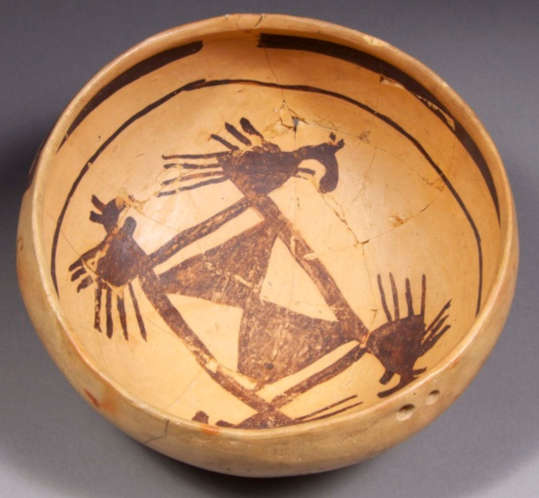Jeddito

Jeddito black-on-yellow bowl
Jeddito is an area running along a ridge overlooking Jeddito Wash. There are ruins of seven major pueblos spread out along the ridge, ruins of pre-Navajo heritage. Only two are not on Navajo land. The others are in the Jeddito Island, a Navajo territory surrounded by the Hopi Reservation. That makes them essentially inaccessible to non-Natives. Awatovi is located on Hopi land and is relatively easy to get to, as long as you are in the company of a Hopi guide.
Jeddito Canyon is where Jeddito yellow clay is found. Potters from the pueblos lining the mesa rim were prolific with it and samples have been found all over the southwestern states. Jeddito black-on-yellow was big for more than 100 years, giving way to Sikyátki Polychrome as it developed in the mid 1400s.
The people of the Jeddito area pueblos spoke several different languages as they migrated in from different areas. From this distance in time it appears the Jeddito area pueblos were where Towa and Keres migrants were first allowed to settle after migrating in from the north, east or south. Many of the people and clans of First, Second and Third Mesas had migrated from the west.
Most of the people at Awatovi spoke either Towa or Keres while nearby Kawaika'a spoke mostly what would now be Western Keres (the Lagunas still know Laguna Pueblo as "Kawaika'a"). Kawaika'a was slowly abandoned during the 1500s with some of the clans and potters relocating to Sikyátki on the north side of First Mesa. A couple generations later (1625 CE) the Hopis of Walpi destroyed Sikyátki, killing nearly everyone and burning the pueblo.
The other pueblos on the edge of Antelope Mesa were older, some in ruins before the first stone was put in place at Awatovi. Old Oraibi on Third Mesa claims to have been about 200 years old when that first stone was placed at Awatovi, too.
The Asa people were Northern Tewa and were first allowed to settle at Hano on First Mesa around 1600 CE. Then they left and moved to Navajo territory before coming back 50 or so years later. On their return they were allowed to settle at Shungopovi with some freshly arrived Zuni migrants. A few years later the Southern Tewa arrived and within a few years, they were allowed to settle into the old village of Hano, separated from Shungopovi by a narrow alleyway.
After the Pueblo Revolt of 1680 a large group of migrants arrived from the Southern Tiwa pueblos along the Rio Grande (Isleta and Alameda/Sandia). They were immediately allowed to settle and build a pueblo at Payupki, on a northerly finger of Second Mesa. In the early 1740s most of them returned to the area of the Rio Grande and Payupki was abandoned, never to be reoccupied.
Early in 1701, Hopis from Walpi, Sichomovi and Oraibi destroyed Awatovi, killing nearly everyone and burning the pueblo.
Looking at this data, it seems as though the Hopis got along better with Tewa, Keres and Zuni migrants than with Towa migrants.
Sites of the Ancients and approximate dates of occupation:
Atsinna : 1275-1350
Awat'ovi : 1200-1701
Aztec : 1100-1275
Bandelier : 1200-1500
Betatakin : 1275-1300
Casa Malpais : 1260-1420
Chaco Canyon : 850-1145
Fourmile Ranch : 1276-1450
Giusewa : 1560-1680
Hawikuh : 1400-1680
Homol'ovi : 1100-1400
Hovenweep : 50-1350
Jeddito : 800-1700
Kawaika'a : 1375-1580
Kuaua : 325-1580
Mesa Verde : 600-1275
Montezuma Castle : 1200-1400
Payupki : 1680-1745
Poshuouingeh : 1375-1500
Pottery Mound : 1320-1550
Puyé : 1200-1580
Snaketown : 300 BCE-1050
Tonto Basin : 700-1450
Tuzigoot : 1125-1400
Wupatki/Wukoki : 500-1225
Wupatupqa : 1100-1250
Yucca House : 1100-1275